As one of the most recognizable structures in Los Angeles, Crossroads of the World is forever imbedded in the fabric of Hollywood history. It’s as much a part of what draws people to the entertainment capital of the world as the Hollywood sign and walk of fame. In true Hollywood fashion, the story of its origins is filled with all the mystery and mayhem of a classic film.
Los Angeles crime boss Charles “Goodtime Charlie” Crawford ran a notorious crime syndicate throughout the 1920’s. Crawford gave public corruption a whole new meaning with members of the government in his pocket. After the law nearly caught up with Crawford, he tried his hand at going legit by opening a real estate and insurance office at 6655 Sunset Boulevard. On May 20, 1931, 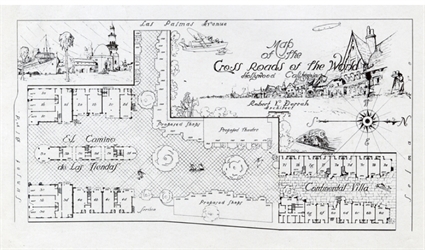
Original 1936 design for a unique shopping center.
Crossroads is now home to dozens of businesses
–a center of creativity for half a century.Crawford was shot dead in his office along with reporter Herbert Spencer. His widow, Ella Crawford, commissioned architect Robert V. Derrah to design what would become one of the nation’s first shopping malls, paying tribute to Crawford and their travels all over the world. In 1936, located at 6671 Sunset Boulevard, Crossroads of the World was born, and the rest they say is history.
Alfred Hitchcock led the entertainment brigade to Crossroads of the World in 1939, opening what would become the first office. The Crossroads transitioned from a shopping center to an artist community filled with talented creatives integral to the heart of entertainment.
In 1977, Graham Nash of the iconic Crosby, Stills and Nash, restored a dilapidated studio. Three decades later, the prestigious Aftermaster Studio took over, inhabiting what was once Hitchcock’s offices. Co- founder and CEO Larry Ryckman reflects on the diverse history of the famed studio. “Everybody came- the Eagles, Linda Ronstadt, Fleetwood Mac. Then it went into disrepair. Homeless people lived in these hallways and offices. Then Mort La Kretz bought the property and completely changed it.”
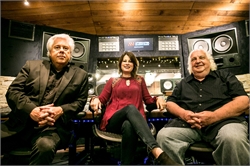
Larry Ryckman, Erin Alden, and Shelly Yakus
of Aftermaster Studio.Studio Manager Erin Alden feels a special connection to the Crossroads. “This lot is so magical. There’s no place I’d rather be than here in Hollywood. I’m here for the people that live in the Midwest and dream about becoming a songwriter or recording artist. You look at the history of all the people that came in during the 70’s like Joni Mitchell, Kris Kristofferson, Jackson Browne, all the people that I loved.”
Co- founder and Chief Engineer Shelly Yakus, known for working alongside some of the most revolutionary artists in music history, appreciates the significance of such a historically creative environment. “It’s like an oasis in the middle of the city. It’s a pretty unusual and special place. Sometimes people say they feel Hitchcock’s vibe. Some of the people that come here to work spend a lot of time here, and I see them becoming more successful. It’s a very inspiring, invigorating place.”
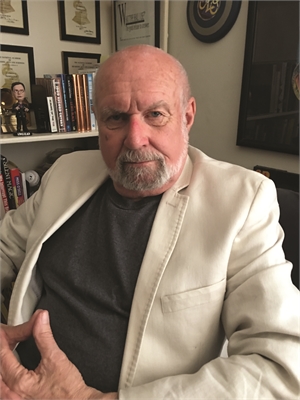
Album designer Kosh.Iconic art director Kosh, who has designed over 2000 album covers, including the Beatles’ “Abbey Road,” and Eagles’ “Hotel California,” has been at Crossroads since 1973, in different spaces throughout the years as his needs changed. Kosh’s clientele, who included such luminaries as Rod Stewart, Linda Ronstadt, Ringo Starr, and the Eagles, visited his office often, contributing to Crossroads lore as a rock and roll oasis, with picnics in the courtyard and occasional overnight escapades. “It’s a fantastic place with so much history. Nancy Reagan had an office here, as did Huell Houser.”
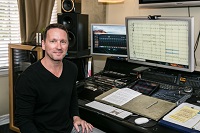
Music composer Don Barrett.Don Barrett, who composes music for film and television, moved to Los Angeles from the Midwest and first came to the Crossroads of the World to take scoring classes. “One of my classes was at the recording studio where Aftermaster is now. I remember the very first time I pulled in here nervous and thinking, ‘What have I done with my life?’ Six years later, I found an office here which I never thought would happen. I’ve loved being here with the history of the creatives.” With an office at Crossroads, he’s reminded of how far he’s come. “I’ve never forgotten what it felt like to be in that legendary studio.”
Located next to Don Barrett is Nigel Daly, publisher of the Laboratory Arts Collective, and Creative Director Louise Salter. The duo ran one of the foremost Avant- garde theater companies in London. Daly reminisces, “We were producing very Avant- garde theater in nightclubs, warehouses, underground cabins, disused stations, pubs, anywhere that was not a theater. It was always multi-media. We had film, dance, performance art, music.”
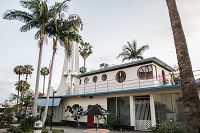
The blend of Moderne and Old
World Architecture includes a
variety of stylistic motifs,
including nautical, English Tudor,
and more, creating an
eclectic and even whimsical
environment in which to work.In 2003, Daly and Salter followed their passion for film and magazines to Los Angeles. Salter explains, “We create the magazines, events around the magazine, and we make films for the magazines. In a way, the magazine is just a starting point. It’s like a diving board to look at the wonders of the world. We tend to be drawn to incredibly talented people, not necessarily the most famous. The one thing they all share is that they are genuinely, authentically talented artists.” It was fate that drew them to the Crossroads of the World. Salter continues, “We’re always looking for historical places that have meaning because that’s how you can feel connected when you come from somewhere else. We did some research into the Crossroads of the World and discovered the rich history. One day driving around Ojai, we accidentally discovered ceramist Beatrice Wood’s studio and learned she’d had a shop here at Crossroads. It felt like this place was calling us.”
Daly reflects on what it’s meant to be at Crossroads. “This place has a diverse creative energy like no other place. I hope it keeps its exquisite spirit and energy because it’s special.”
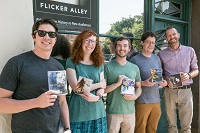
Jeff Masino (far right)
with the staff of Flicker Alley.President and founder of Flicker Alley Jeffrey Masino connects the past with the present. “Flicker Alley creates new, digital editions of mostly silent films. I grew up in Los Angeles and was fascinated with the history. I’m thankful to work at Crossroads.” Exposing audiences to the silent films of the past has a historic significance that younger generations can learn from. “There’s so much going on in the world that has historical ties. Movies from the silent era are a fascinating window into what people thought about the world. You get a sense of what it was like then and can relate it to present day. It’s fascinating to see human nature be so consistent.”
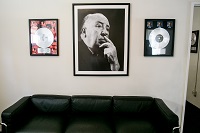
Photo of Alfred Hitchcock in
Aftermaster Studios honors the director
whose offices were once in the same space.Crossroads of the World is home to some of the most influential minds in the entertainment industry. A pioneer in publishing for nearly forty years, Taschen is one of the most successful book publishers in the world. Frequently seen are actors and models visiting casting offices located in the complex. Casting director Sheila Jaffe is responsible for placing talent in features like “Rocky Balboa” and “Ted.” Schulman Photo Lab specializes in archival exhibition printing for galleries, museums, archives, estates, and artists.
In this oasis in the middle of Hollywood, it’s not hard to imagine F. Scott Fitzgerald or Alfred Hitchcock walking the grounds or the endless stream of talent that has walked on and off the lot for the last eighty years. The Crossroads of the World represents the essence of Hollywood; all are welcome to follow their dreams, and while the world around it may change, history always remains.

